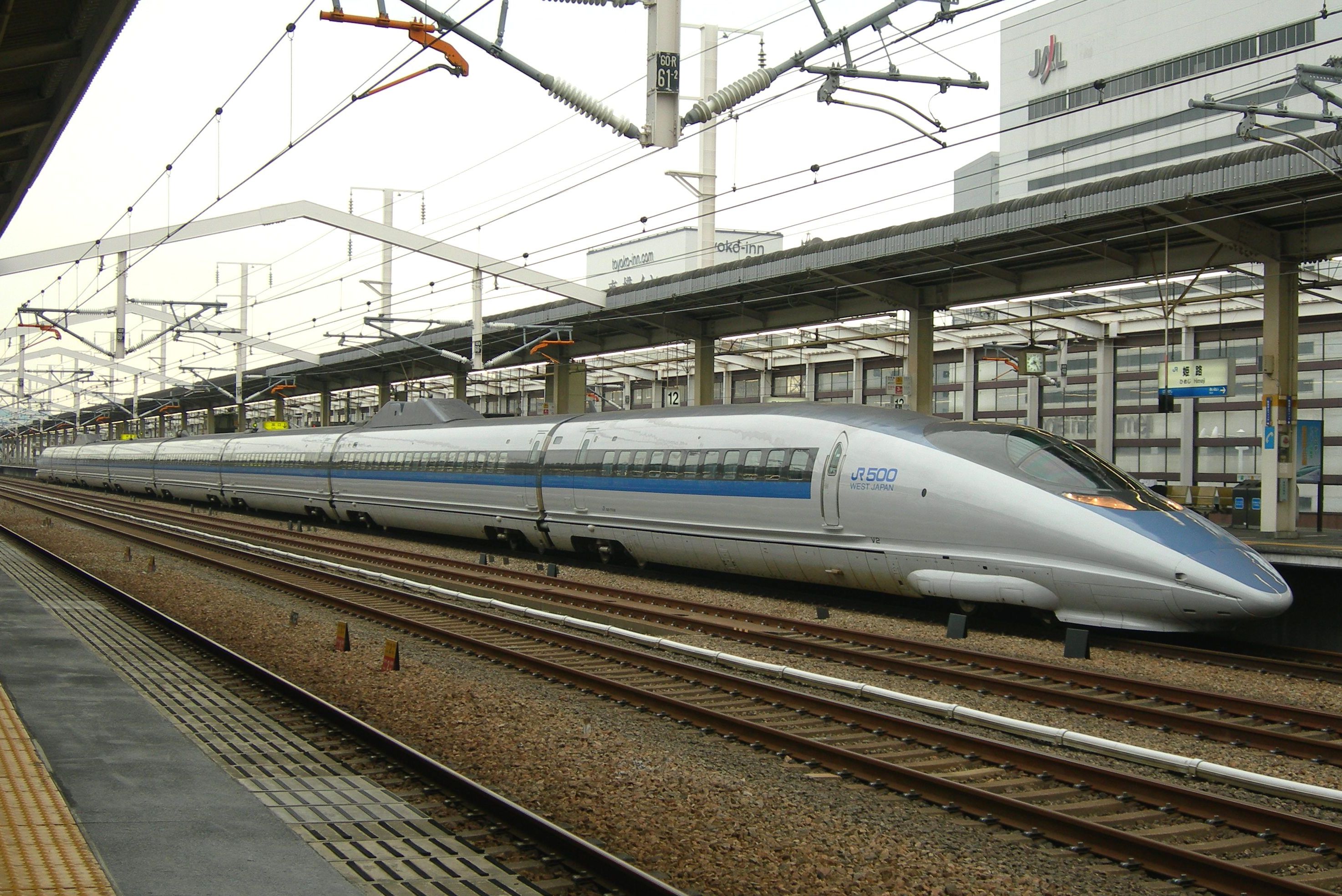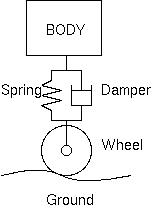|
500 Series Shinkansen
The is a Shinkansen high-speed train type operated by West Japan Railway Company (JR-West) on the Tōkaidō Shinkansen and San'yō Shinkansen lines in Japan since 1997. They were designed to be capable of but operated at , until they were finally retired from the primary '' Nozomi'' service in 2010. The trainsets were then refurbished and downgraded to the all-stations '' Kodama'' service between and . Overview The general design concept was overseen by German industrial designer Alexander Neumeister. The running gear utilizes computer-controlled active suspension for a smoother, safer ride, and yaw dampers are fitted between cars for improved stability. All sixteen cars in each original trainset were powered, giving a maximum of . Each train cost an estimated 5 billion yen, and only nine were built. It used biomimicry to reduce energy consumption by 15%, increase speeds by 10% and reduce noise levels while increasing passenger comfort. This was done by making the train's fr ... [...More Info...] [...Related Items...] OR: [Wikipedia] [Google] [Baidu] |
Himeji Station
is a passenger railway station located in the city of Himeji, Japan, operated by West Japan Railway Company (JR West). Himeji is a major stop on the San'yō Main Line and the Sanyō Shinkansen, and the western end of the JR Kobe Line. The station building is located close to the Sanyo Electric Railway Himeji Station and Himeji Castle. Lines Himeji Station is served by the JR San'yō Main Line, and is located 54.8 kilometers from the terminus of the line at and 87.9 kilometers from . On the Shinkansen network it is 91.7 kilometers from Shin-Osaka and 644.3 kilometers from . The 65.7 kilometer Bantan Line to and the 158.1 kilometer Kishin Line to terminate at Himeji Station. Station layout The station has a complex layout of elevated platforms. The conventional trains operate from four island platforms, the first two of which have one dead-headed track each. The Shinkansen portion of the station has one side platform and one island platform with two passing trains between ... [...More Info...] [...Related Items...] OR: [Wikipedia] [Google] [Baidu] |
San'yō Shinkansen
The is a line of the Japanese Shinkansen high-speed rail network, connecting Shin-Osaka in Osaka with Hakata Station in Fukuoka, the two largest cities in western Japan. Operated by the West Japan Railway Company (JR West), it is a westward continuation of the Tōkaidō Shinkansen and also serves other major cities in between on Honshu and Kyushu islands such as Kobe, Himeji, Okayama, Hiroshima, and Kitakyushu. The Kyushu Shinkansen continues south of Hakata to Kagoshima. The San'yō Shinkansen connects Hakata with Osaka in two and a half hours, with trains operating at a maximum operating speed of for most of the journey Some '' Nozomi'' trains operate continuously on San'yō and Tōkaidō Shinkansen lines, connecting Tokyo and Hakata in five hours. Rolling stock As of March 2020, the following types are used on San'yō Shinkansen services. * 500 series: '' Kodama'' services * 700–7000 series: ''Hikari'' / '' Kodama'' services * N700 series: '' Nozomi'' / ''Hikari'' / '' Ko ... [...More Info...] [...Related Items...] OR: [Wikipedia] [Google] [Baidu] |
Neon Genesis Evangelion
, also known simply as ''Evangelion'' or ''Eva'', is a Japanese mecha anime television series produced by Gainax and animated by Tatsunoko, directed by Hideaki Anno and broadcast on TV Tokyo from October 1995 to March 1996. ''Evangelion'' is set fifteen years after a worldwide cataclysm, particularly in the futuristic fortified city of Tokyo-3. The protagonist is Shinji Ikari, a teenage boy who is recruited by his father Gendo to the shadowy organization Nerv to pilot a giant bio-machine mecha named " Evangelion" into combat against beings known as "Angels". The series explores the experiences and emotions of Evangelion pilots and members of Nerv as they try to prevent Angels from causing more cataclysms. In the process, they are called upon to understand the ultimate causes of events and the motives for human action. The series has been described as a deconstruction of the mecha genre and it features archetypal imagery derived from Shinto cosmology as well as Jewish a ... [...More Info...] [...Related Items...] OR: [Wikipedia] [Google] [Baidu] |
N700 Series Shinkansen
The is a Japanese Shinkansen high-speed train with tilting capability developed jointly by JR Central and JR West for use on the Tokaido and San'yō Shinkansen lines since 2007, and also operated by JR Kyushu on the Kyushu Shinkansen line. N700 series trains have a maximum speed of , and tilting of up to one degree allows the trains to maintain even on radius curves that previously had a maximum speed of . Another feature of the N700 is that it accelerates more quickly than the older 700 series Shinkansen trains, with a maximum acceleration rate of 2.6 km/h/s (0.72 m/s2). This enables it to reach in only three minutes. Further advancements led to the development of the N700A, an incremental evolution of the N700. N700A trains can reach 285 km/h on 3,000 m curves, allowing the maximum operating speed on the Tōkaidō Shinkansen to be raised to 285 km/h. All N700 series sets have been retrofitted with most of the improvements added to the N700A series, and ... [...More Info...] [...Related Items...] OR: [Wikipedia] [Google] [Baidu] |
Hikari (train)
is the name of a high-speed train service running on the Tokaido and San'yō Shinkansen "bullet train" lines in Japan. Slower than the premier '' Nozomi'' but faster than the all-stations '' Kodama'', the ''Hikari'' is the fastest train service on the Tokaido and Sanyo Shinkansen that can be used with the Japan Rail Pass, which is not valid for travel on the ''Nozomi'' or ''Mizuho'' trains. Service variations ''West Hikari'' These services first appeared in 1988 on the Sanyo Shinkansen between Shin-Osaka and Hakata using 6-car 0 series trains. 0 series 12-car SK units were employed on these services from 1989. From 11 March 2000, they were mostly replaced by the new 700 series ''Hikari Rail Star'' services, and were finally withdrawn on 21 April 2000. ''Grand Hikari'' These were the premier services operated between Tokyo and Hakata from 11 March 1989 using JR West 16-car 100 series V sets with four double-deck centre cars including a restaurant car. These operated at a m ... [...More Info...] [...Related Items...] OR: [Wikipedia] [Google] [Baidu] |
Kingfisher
Kingfishers are a family, the Alcedinidae, of small to medium-sized, brightly colored birds in the order Coraciiformes. They have a cosmopolitan distribution, with most species found in the tropical regions of Africa, Asia, and Oceania, but also can be seen in Europe. They can be found in deep forests near calm ponds and small rivers. The family contains 114 species and is divided into three subfamilies and 19 genera. All kingfishers have large heads, long, sharp, pointed bills, short legs, and stubby tails. Most species have bright plumage with only small differences between the sexes. Most species are tropical in distribution, and a slight majority are found only in forests. They consume a wide range of prey usually caught by swooping down from a perch. While kingfishers are usually thought to live near rivers and eat fish, many species live away from water and eat small invertebrates. Like other members of their order, they nest in cavities, usually tunnels dug into ... [...More Info...] [...Related Items...] OR: [Wikipedia] [Google] [Baidu] |
Biomimicry
Biomimetics or biomimicry is the emulation of the models, systems, and elements of nature for the purpose of solving complex human problems. The terms "biomimetics" and "biomimicry" are derived from grc, βίος (''bios''), life, and μίμησις ('' mīmēsis''), imitation, from μιμεῖσθαι (''mīmeisthai''), to imitate, from μῖμος (''mimos''), actor. A closely related field is bionics. Living organisms have evolved well-adapted structures and materials over geological time through natural selection. Biomimetics has given rise to new technologies inspired by biological solutions at macro and nanoscales. Humans have looked at nature for answers to problems throughout their existence. Nature has solved engineering problems such as self-healing abilities, environmental exposure tolerance and resistance, hydrophobicity, self-assembly, and harnessing solar energy. History One of the early examples of biomimicry was the study of birds to enable human flight. Alt ... [...More Info...] [...Related Items...] OR: [Wikipedia] [Google] [Baidu] |
Yaw Damper (railroad)
A yaw damper is a transverse mounted shock absorber used to prevent railcars and locomotives A locomotive or engine is a rail transport vehicle that provides the motive power for a train. If a locomotive is capable of carrying a payload, it is usually rather referred to as a multiple unit, motor coach, railcar or power car; the ... from swaying excessively from side to side. Yaw dampers prevent locomotives and passenger railcars from striking station platforms as they roll past them and reduce the gap that must be left between the railroad vehicle and the platform, improving safety. References External linksRailroad Yaw Damper Field Manual Rail technologies {{Rail-transport-stub ... [...More Info...] [...Related Items...] OR: [Wikipedia] [Google] [Baidu] |
Active Suspension
An active suspension is a type of automotive suspension on a vehicle. It uses an onboard system to control the vertical movement of the vehicle's wheels relative to the chassis or vehicle body rather than the passive suspension provided by large springs where the movement is determined entirely by the road surface. Active suspensions are divided into two classes: real active suspensions, and adaptive or semi-active suspensions. While semi-adaptive suspensions only vary shock absorber firmness to match changing road or dynamic conditions, active suspensions use some type of actuator to raise and lower the chassis independently at each wheel. These technologies allow car manufacturers to achieve a greater degree of ride quality and car handling by keeping the tires perpendicular to the road in corners, allowing better traction and control. An onboard computer detects body movement from sensors throughout the vehicle and, using that data, controls the action of the active and semi-act ... [...More Info...] [...Related Items...] OR: [Wikipedia] [Google] [Baidu] |








